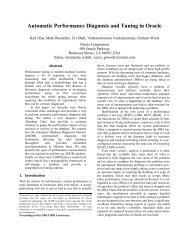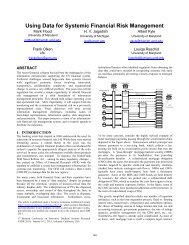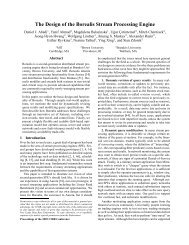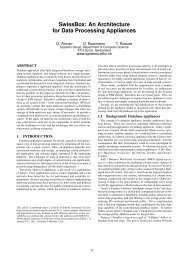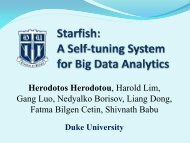Query Processing for Sensor Networks - CIDR
Query Processing for Sensor Networks - CIDR
Query Processing for Sensor Networks - CIDR
You also want an ePaper? Increase the reach of your titles
YUMPU automatically turns print PDFs into web optimized ePapers that Google loves.
SELECT AVG(R.concentration)<br />
FROM Chemical<strong>Sensor</strong> R<br />
WHERE R.loc IN region<br />
HAVING AVG(R.concentration) > T<br />
DURATION (now,now+3600)<br />
EVERY 10<br />
Figure 4: Example Aggregate <strong>Query</strong><br />
clause classifies sensor records into different partitions<br />
according to some attributes, and the HAVING clause<br />
eliminates groups by a predicate. Note that it is possible<br />
to have join queries by specifying several relations<br />
in the FROM clause.<br />
One difference between our query template and<br />
SQL is that our query template has additional support<br />
<strong>for</strong> long running, periodic queries. Since many sensor<br />
applications are interested in monitoring an environment<br />
over a longer time-period, long-running queries<br />
that periodically produce answers about the state of<br />
the network are especially important. The DURA-<br />
TION clause specifies the life time of a query and the<br />
EVERY clause determines the rate of query answers:<br />
we compute a query answer every e seconds (see Figure<br />
3 [21]). We call the process of computing a query<br />
answer a round. The focus of this paper is the computation<br />
of aggregate queries, in which a set of sensor<br />
readings is summarized into a single statistic.<br />
Note that our query template has only limited usage<br />
<strong>for</strong> event-oriented applications. For example, to monitor<br />
whether the average concentration of a chemical is<br />
above a certain threshold, we can use the long-running<br />
query shown in Figure 4, but there is a delay of 10<br />
seconds between every recomputation of the average.<br />
Event oriented applications are an interesting topic <strong>for</strong><br />
future research, as the query processing strategies that<br />
we propose are optimized <strong>for</strong> long-running periodic<br />
queries, and not event-oriented queries and triggers.<br />
3 Simple Aggregate <strong>Query</strong> <strong>Processing</strong><br />
A simple aggregate query is an aggregate query without<br />
Group By and Having clauses, a very popular class<br />
of queries in sensor networks [21]. In this section we<br />
outline how to process such simple aggregate queries.<br />
<strong>Query</strong> processing strategies <strong>for</strong> more general queries<br />
are discussed in Section 5.<br />
3.1 In-Network Aggregation<br />
A query plan <strong>for</strong> a simple aggregate query can be divided<br />
into two components. Since queries require data<br />
from spatially distributed sensors, we need to deliver<br />
records from a set of distributed nodes to a central<br />
destination node <strong>for</strong> aggregation by setting up suitable<br />
communication structures <strong>for</strong> delivery of sensor<br />
records within the network. We call this part of a<br />
query plan its communication component, and we call<br />
the destination node the leader of the aggregation. In<br />
addition, the query plan has a computation component<br />
that computes the aggregate at the leader and potentially<br />
computes already partial aggregates at intermediate<br />
nodes.<br />
Recall that power is one of the main design desiderata<br />
when devising query processing strategies <strong>for</strong> sensor<br />
networks. If we coordinating both the computation<br />
and communication component of a query plan, we<br />
can compute partial aggregates at intermediate nodes<br />
as long as they are well-synchronized; this reduces the<br />
number of messages sent and thus saves power. We<br />
address synchronization in the next section, and consider<br />
here three different techniques on how to integrate<br />
computation with communication:<br />
Direct delivery. This is the simplest scheme.<br />
Each source sensor node sends a data packet consisting<br />
of a record towards the leader, and the multi-hop<br />
ad-hoc routing protocol will deliver the packet to the<br />
leader. Computation will only happen at the leader<br />
after all the records have been received.<br />
Packet merging. In wireless communication, it is<br />
much more expensive to send multiple smaller packets<br />
instead of one larger packet, considering the cost of reserving<br />
the channel and the payload of packet headers.<br />
Since the size of a sensor record is usually small and<br />
many sensor nodes in a small region may send packets<br />
simultaneously to process the answer <strong>for</strong> a round<br />
of a query, we can merge several records into a larger<br />
packet, and only pay the packet overhead once per<br />
group of records. For exact query answers with holistic<br />
aggregate operators like Median, packet merging is<br />
the only way to reduce the number of bytes transmitted<br />
[10].<br />
Partial aggregation. For distributive and algebraic<br />
aggregate operators [10], we can incrementally<br />
maintain the aggregate in constant space, and thus<br />
push partial computation of the aggregate from the<br />
leader node to intermediate nodes. Each intermediate<br />
sensor node will compute partial results that contain<br />
sufficient statistics to compute the final result.<br />
3.2 Synchronization<br />
To per<strong>for</strong>m packet merging or partial aggregation, we<br />
need to coordinate sensor nodes within the communication<br />
component of a query plan. A node n needs<br />
to decide whether other nodes n 1 , . . . , n k are going to<br />
route data packets through n; in this case n has the<br />
opportunity of either packet merging or partial aggregation.<br />
Thus a node n needs to build a list of nodes<br />
it is expecting messages from, and it needs to decide<br />
how long to wait be<strong>for</strong>e sending a message to the next<br />
hop.<br />
For duplicate sensitive aggregate operators, like<br />
SUM and AVG, one prerequisite to per<strong>for</strong>m partial aggregation<br />
is to send each record only once, otherwise<br />
duplicate records might appear in partially aggregated



